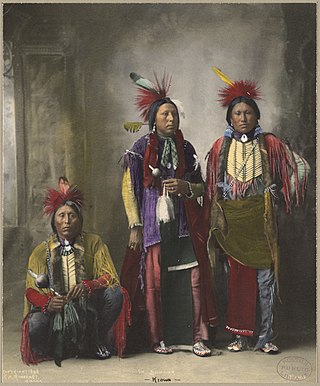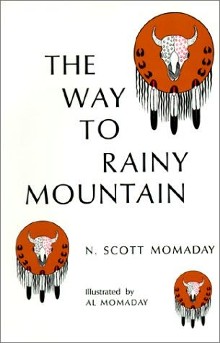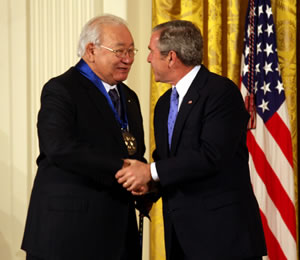
Kiowa people are a Native American tribe and an indigenous people of the Great Plains of the United States. They migrated southward from western Montana into the Rocky Mountains in Colorado in the 17th and 18th centuries, and eventually into the Southern Plains by the early 19th century. In 1867, the Kiowa were moved to a reservation in southwestern Oklahoma.

Leslie Marmon Silko is an American writer. A Laguna Pueblo Indian woman, she is one of the key figures in the First Wave of what literary critic Kenneth Lincoln has called the Native American Renaissance.

Gerald Robert Vizenor is an American writer and scholar, and an enrolled member of the Minnesota Chippewa Tribe, White Earth Reservation. Vizenor also taught for many years at the University of California, Berkeley, where he was Director of Native American Studies. With more than 30 books published, Vizenor is Professor Emeritus at the University of California, Berkeley, and Professor of American Studies at the University of New Mexico.

Bury My Heart at Wounded Knee: An Indian History of the American West is a 1970 non-fiction book by American writer Dee Brown that covers the history of Native Americans in the American West in the late nineteenth century. The book expresses details of the history of American expansionism from a point of view that is critical of its effects on the Native Americans. Brown describes Native Americans' displacement through forced relocations and years of warfare waged by the United States federal government. The government's dealings are portrayed as a continuing effort to destroy the culture, religion, and way of life of Native American peoples. Helen Hunt Jackson's 1881 book A Century of Dishonor is often considered a nineteenth-century precursor to Dee Brown's book.

House Made of Dawn is a 1968 novel by N. Scott Momaday, widely credited as leading the way for the breakthrough of Native American literature into the mainstream. It was awarded the Pulitzer Prize for Fiction in 1969, and has also been noted for its significance in Native American anthropology.

The Way to Rainy Mountain (1969) is a book by Pulitzer Prize winning author N. Scott Momaday. It is about the journey of Momaday's Kiowa ancestors from their ancient beginnings in the Montana area to their final war and surrender to the United States Cavalry at Fort Sill, and subsequent resettlement near Rainy Mountain, Oklahoma.

The Institute of American Indian Arts (IAIA) is a public tribal land-grant college in Santa Fe, New Mexico. The college focuses on Native American art. It operates the Museum of Contemporary Native Arts (MoCNA), which is housed in the historic Santa Fe Federal Building, a landmark Pueblo Revival building listed on the National Register of Historic Places as Federal Building. The museum houses the National Collection of Contemporary Indian Art, with more than 7,000 items.

The eagle bone whistle is a religious object, used by some members of Native American spiritual societies in sacred ceremonies. They are made from bones of either the American bald eagle or the American golden eagle, and are considered powerful spiritual objects.
The Native American Renaissance is a term originally coined by critic Kenneth Lincoln in the 1983 book Native American Renaissance to categorise the significant increase in production of literary works by Native Americans in the United States in the late 1960s and onwards. A. Robert Lee and Alan Velie note that the book's title "quickly gained currency as a term to describe the efflorescence on literary works that followed the publication of N. Scott Momaday's House Made of Dawn in 1968". Momaday's novel garnered critical acclaim, including the Pulitzer Prize for Fiction in 1969.

Luci Tapahonso is a Navajo poet and a lecturer in Native American Studies. She is the first poet laureate of the Navajo Nation, succeeded by Laura Tohe.

Navarre Scott Momaday is a Kiowa novelist, short story writer, essayist, and poet. His novel House Made of Dawn was awarded the Pulitzer Prize for Fiction in 1969, and is considered the first major work of the Native American Renaissance. His follow-up work The Way to Rainy Mountain blends folklore with memoir. Momaday received the National Medal of Arts in 2007 for his work's celebration and preservation of indigenous oral and art tradition. He holds twenty honorary degrees from colleges and universities, and is a fellow of the American Academy of Arts and Sciences.
Native Americans have been featured in numerous works of children's literature. Some have been authored by non-Indigenous writers, while others have been written or contributed to by Indigenous authors.

Simon J. Ortiz is a Native American writer, poet, and enrolled member of the Pueblo of Acoma. Ortiz is one of the key figures in the second wave of what has been called the Native American Renaissance.
Joseph Bruchac is an American writer and storyteller based in New York.
Anna Lee Walters is a Pawnee/Otoe-Missouria author.

Storyteller is a collection of works, including photographs, poetry, and short stories by Leslie Marmon Silko. It is her second published book, following Ceremony. The work is a combination of stories and poetry inspired by traditional Laguna Pueblo storytelling. Silko's writings in Storyteller are influenced by her upbringing in Laguna, New Mexico, where she was surrounded by traditional Laguna Pueblo values but was also educated in a Euro-American system. Her education began with kindergarten at a Bureau of Indian Affairs school called the Laguna Day School "where the speaking of the Laguna language was punished."
Native American literature is literature, both oral and written, produced by Native Americans in what is now the United States, from pre-Columbian times through to today. Famous authors include N. Scott Momaday, Leslie Marmon Silko, Simon Ortiz, Louise Erdrich, Gerald Vizenor, Joy Harjo, Sherman Alexie, D'Arcy McNickle, James Welch, Charles Eastman, Mourning Dove, Zitkala-Sa, John Rollin Ridge, Lynn Riggs, Diane Glancy, Hanay Geiogamah, William Apess, Samson Occom, et al. Importantly, it is not "a" literature, but a set of literatures, since every tribe has its own cultural traditions. Since the 1960s, it has also become a significant field of literary studies, with academic journals, departments, and conferences devoted to the subject.
Indigenous cultures in North America engage in storytelling about morality, origin, and education as a form of cultural maintenance, expression, and activism. Falling under the banner of oral tradition, it can take many different forms that serve to teach, remember, and engage Indigenous history and culture. Since the dawn of human history, oral stories have been used to understand the reasons behind human existence. Today, Indigenous storytelling is part of the broader indigenous process of building and transmitting indigenous knowledge.

Race to the Sun is a novel written by Rebecca Roanhorse and was published on January 14, 2020. It is one of many books in the Rick Riordan Presents imprint, and focuses on Navajo mythology. The book follows Nizhoni Begay, who has the self-proclaimed power of detecting monsters, as she adventures with her brother, Mac, and her best friend, Davery Descheny, through a series of trials to the House of the Sun to find her father, who was taken by the mysterious Mr. Charles.

A Radiant Curve is a compilation of poems and stories written by professor Luci Tapahonso. It is one of six collective poetry works by Tapahonso. A Radiant Curve is a work with basis in daily life, which is closely related to Luci Tapahonso's Navajo culture. These stories include memories of her family, generational teachings, and her perspective as a Navajo person living in modern times. A Radiant Curve tries to emphasize storytelling in order to speak to the commonality of the shared human experience across cultures as evidenced by the double use of both Navajo and English. The book was published in 2008 by The University of Arizona Press.













